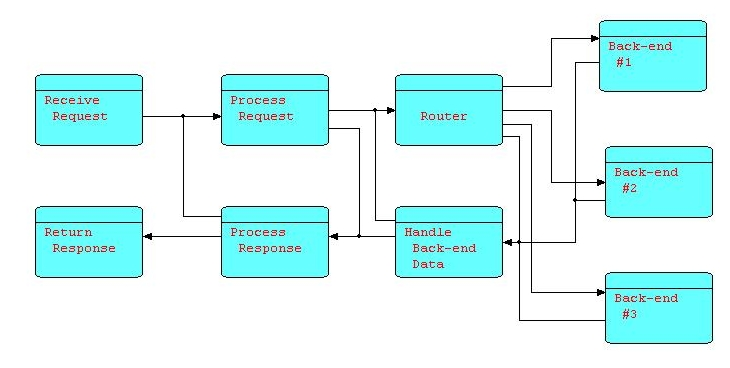
by Gary Mintchell | Aug 16, 2013 | Automation, Technology

Source: Wikipedia
It is interesting, or maybe coincidental, that I had just left the National Instruments user conference about Graphical Programming (among other things) when I downloaded a Robert Scoble podcast interview with the principles of a new company who just launched a flow chart programming tool for high-tech programmers. (I couldn’t find a link for Scoble, but search Scobleizer on iTunes.)
The company has released No Flow JS and many companies had picked it up. A sample of the Flow Diagram Programming accompanies this post.
This brought back all the memories of flow-chart programming from the 90s. The only company still successfully pushing that paradigm to my knowledge is Opto 22. Phoenix Contact picked up the remnants of Think ‘n Do and Steeplechase many years ago. I can remember when the latter two companies thought that everyone would flock to their controllers because it was so much easier and more understandable to program in with flow charts than ladder diagram.
Unfortunately for them, engineers were afraid of the control platform–a PC. I told the CEOs for years that they should stop arguing in their ads about whose real-time operating system was better and concentrate on why engineers should switch from PLCs to the new platform. Meanwhile, Opto 22 found its niche and happily keeps customers happy with its controller and flow-chart programming.
NI uses a paradigm much like function block programming. I have programmed in LabView and recommend it over Ladder. On the other hand, I realize that there remain many thousands of technicians who are quite comfortable in Ladder. But even for those who love Structured Text, perhaps they should take a look at flow chart programming. If it’s coming to mainstream programming, could industrial be far behind?
by Gary Mintchell | Jul 29, 2013 | Operations Management
Here is an interesting new product announcement. Interesting because in a world where so many programmable logic controllers (PLCs) have pretty much become commodity items, here is an MES supplier who is launching a new PLC–to enhance its MES solution.
I asked for an interview with a product manager to dive a little deeper into this. Suddenly I realized that a couple of weeks have passed with no further response from my media relations contact. So, this is as much as I know right now.
IQMS, a manufacturing ERP software and MES developer, has released its Process Monitoring Interface Unit (PMIU) Programmable Logic Controller (PLC). The PMIU88 OEM PLC is designed for the shop floor to control or monitor process variables. A “multitude of sensors” are available including thermocouples, pressure transducers and linear potentiometers and digital inputs that communicate directly to IQMS’ RealTime Process Monitoring system for control and SPC analysis.
“Through mounting of our own sensors, IQMS can offer a low cost option for cases where there is no PLC or controller at the work center, thus expanding the types of equipment that we can connect to,” said Glenn Nowak, vice president at IQMS. “By offering PLCs that are designed specifically to interface with EnterpriseIQ, we can deliver a more comprehensive offering for our MES solution.”
Shipped complete with its i-TRiLOGI ladder + BASIC software and a built-in Ethernet port with onboard web server, the PMIU88 PLC is ready for work center monitoring and configuration remotely over the network. For communication, Modbus communication protocols and RS232 and RS485 connections are included.
Once installed, the PMIU88 PLCs will push product data to the IP-based RealTime Process Monitoring system for correlation and analysis in real time. IQMS’ RealTime Process Monitoring solution is a flexible, robust manufacturing intelligence system that gathers and stores any process parameters necessary for accurate traceability back to the item number, work order, lot number and manufactured date and time.
Stored in an SQL-based data historian, Process Monitoring information can then be viewed dynamically in charts or gauges, including Overall Equipment Effectiveness (OEE) calculations. Additionally, data can then be analyzed in the EnterpriseIQ Statistical Process Control (SPC) module for accurate and instantaneous feedback, including business activity notifications through voice alerts or email/text warnings if products are trending out of specification.







